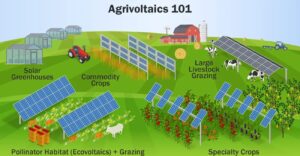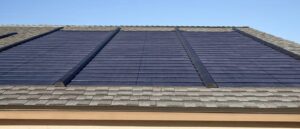It’s time to talk about a technology that has been around since the origins of man. Actually, it predates man because most of the animal and even plant kingdom has been using this technology for millenia. What is it? Passive Solar.
The term “solar” means most directly, “sun”. There is some confusion out there when people hear the term “passive solar” and most often, people think of solar hot water systems or photovoltaics. These systems are most definately solar systems, but they are “active” systems that convert or store the sun’s energy for some specific purpose. Passive solar systems are much more subtle and in most cases, much less expensive too.
Consider this: when the anasazi indians in Southern Colorado selected the perfect cliffs to build their dwellings in, it is no coincidence that they all faced the same direction. It is also not just chance that nearly every village in pre-1900’s Europe also has a bulk of it’s structures facing the same direction. And it’s why most of us in Colorado really don’t want their garage doors facing the wrong direction in the Winter.
So which direction am I talking about? Well, the answer to that depends on where you live. For those of us in the northern hemisphere, that direction will be South. The ancients of the northern lattitudes made very sure that their dwellings faced due south because they learned that the winter sun would shine directly into their homes during the day and in the hot summertime, the sun was naturally shaded. Some of these ancients even went on to develop the very same solar charts that we use today in passive solar design.
Somehow, that technology got lost somewhere during the industrial period and with energy being relatively cheap in the last century, a huge number of buildings have been built with no regard to the centuries of knowledge laid out before us. There have always been those who carried the torch for these old methods and fortunately, it is now time to unearth this ancient wisdom and bring it back into every new structure we build. For some of us, it has always come more naturally than for others.
Passive solar is just that. Natural. Passive sun. No moving parts. No special equipment. Instead, a careful design of the orientation, glass and shading of the building so that the sun’s energy can be harnessed when you need it and shaded when you don’t. A study of the seasonal sun charts in the context of your site, lattitude, climate and a variety of other variables including nearby vegetation, prevailing winds and neighboring structures all contribute to a comprehensive look at how your home or office can be designed to maximize the opportunities for passive solar design.
We’ve designed a number of off-grid homes and while we need to have active systems to generate electricity for the home, the single biggest thing we do for these projects is reduce the heating and cooling loads with careful passive solar design. After all, the heating and cooling loads in a home comprise the largest majority of the energy usage in the home.
How do we do this? Well, first of all, we start with a site that has good southern exposure. If the site is large, we find the best place to locate the home. A small site on a south face works equally well. Some sites are much more constrained and if you happen to own a tenth-acre lot on the north side of a heavily treed mountain, well then I’m sorry my friend, but you may want to consider finding someone else who is willing to lay to waste the wisdom of their forefathers that you can unload that cold uninhabitable plot onto so you can look elsewhere in the neighborhood for something that can see the sun. Otherwise, you can plan to spend a lot on your energy needs. My point here is: the site is crucial to good passive solar design.
Once we have a good southern-exposed site, we design the home so that it’s long axis runs parallel with the southern exposure. This insures that we can get plenty of glass in that south facing wall. Why do we want that? Simple – the winter sun that is low in the sky rises in the southeast and sets in the southwest and hangs lower in the southern sky all day long. This allows the home to let that light and heat in all day long. In the Summer, the sun shifts and will rise in the northeast and set in the northwest and be directly overhead in the middle of the day. Your south facing windows will be shaded and keep the home from overheating. Pay attention to where your home gets the sun different times of year. This is a predictable pattern that can be utilized in good passive solar design. And is also why poorly designed homes can be cold in winter and overheat in the summer. Bear in mind that this scenario is specific to the northern lattitudes. Everything is opposite in the southern hemisphere (even the toilets flush backwards, so I’ve heard).
All of this so far has cost nothing. passive. passive solar. But we’re not done yet. We need to find a way to store some of the sun’s energy so that at night when there is no sun, we can release that energy and sustain the comfort inside the home until the sun comes back up. We do this with thermal mass (see my other blog, “the skinny on thermal mass”). If we can store the sun’s energy that comes through that south facing glass in the floor and walls with heavy, dense materials that have a high heat coeffecient, we can sustain that heat through the night and make it to another day. In some cases of exceptionally good design, you can sustain several days without sun. Keeping the heat in the home with good insulation and an airtight shell is very important as well. There are some excellent technologies available now with windows that further help to let the heat in and trap it inside the home, but that is perhaps another post for another day.
There are countless methods and equations that we use as designers to quantify the right amount of glass and mass necessary for a functional passive solar design, and it varies for different locations and different climates. There are even special materials that you can use to optimize the storage of the heat and store more of it for longer periods of time.
Entire communities are now paying attention to this phenomena and instead of suburban sprawl that turned it’s back (figuratively and literally) on these fundamental design elements, we’re now seeing entire neighborhoods that are master planned to integrate passive solar into each and every lot. Coming back to the roots of our civilization, but perhaps not to go quite so far as a cliff dwelling. The bottom line here is that every building should make some attempt to utilize this free technology because ignoring the tremendous benefits of such simple and ancient wisdom is just that – ignorance.









